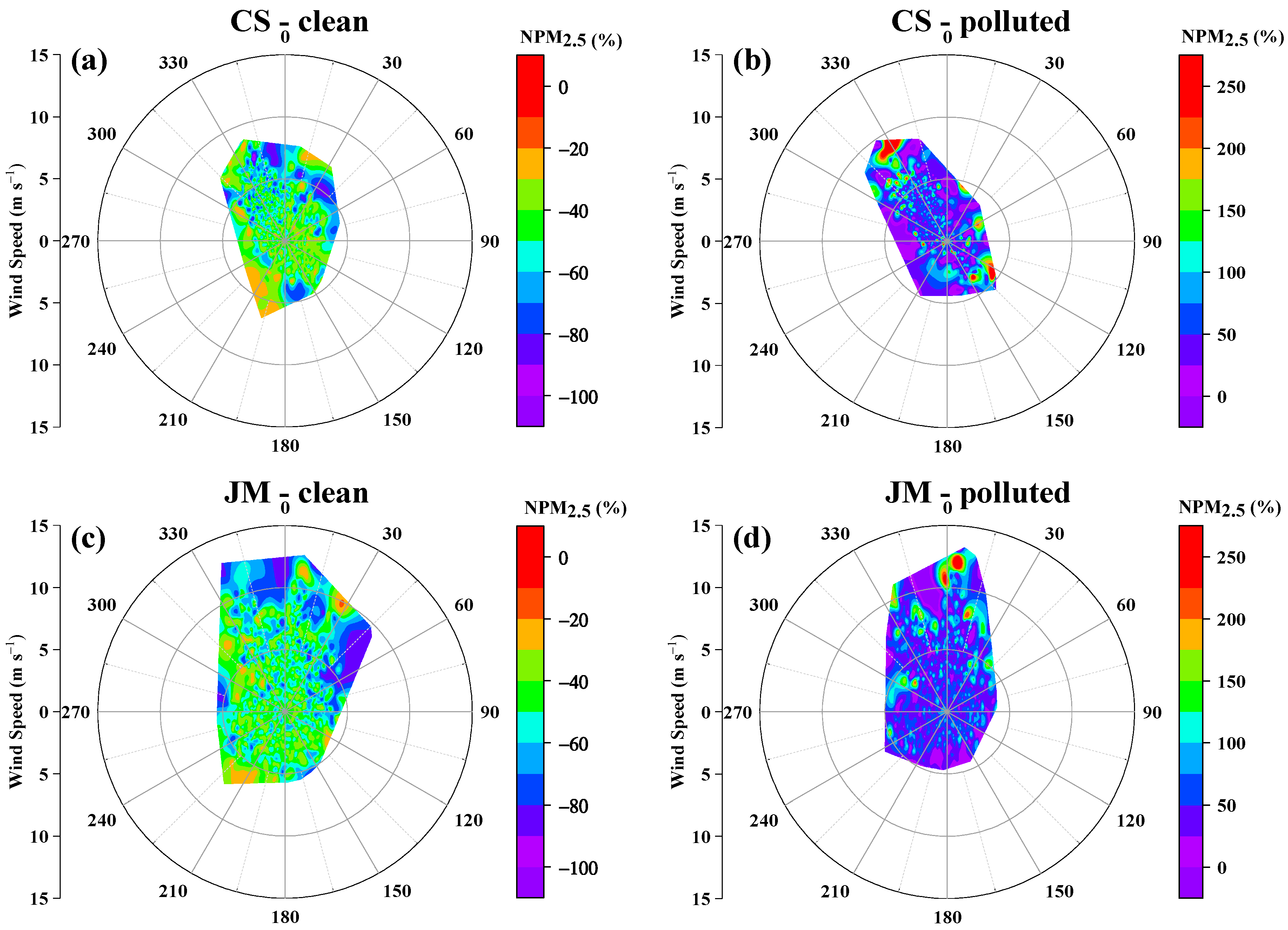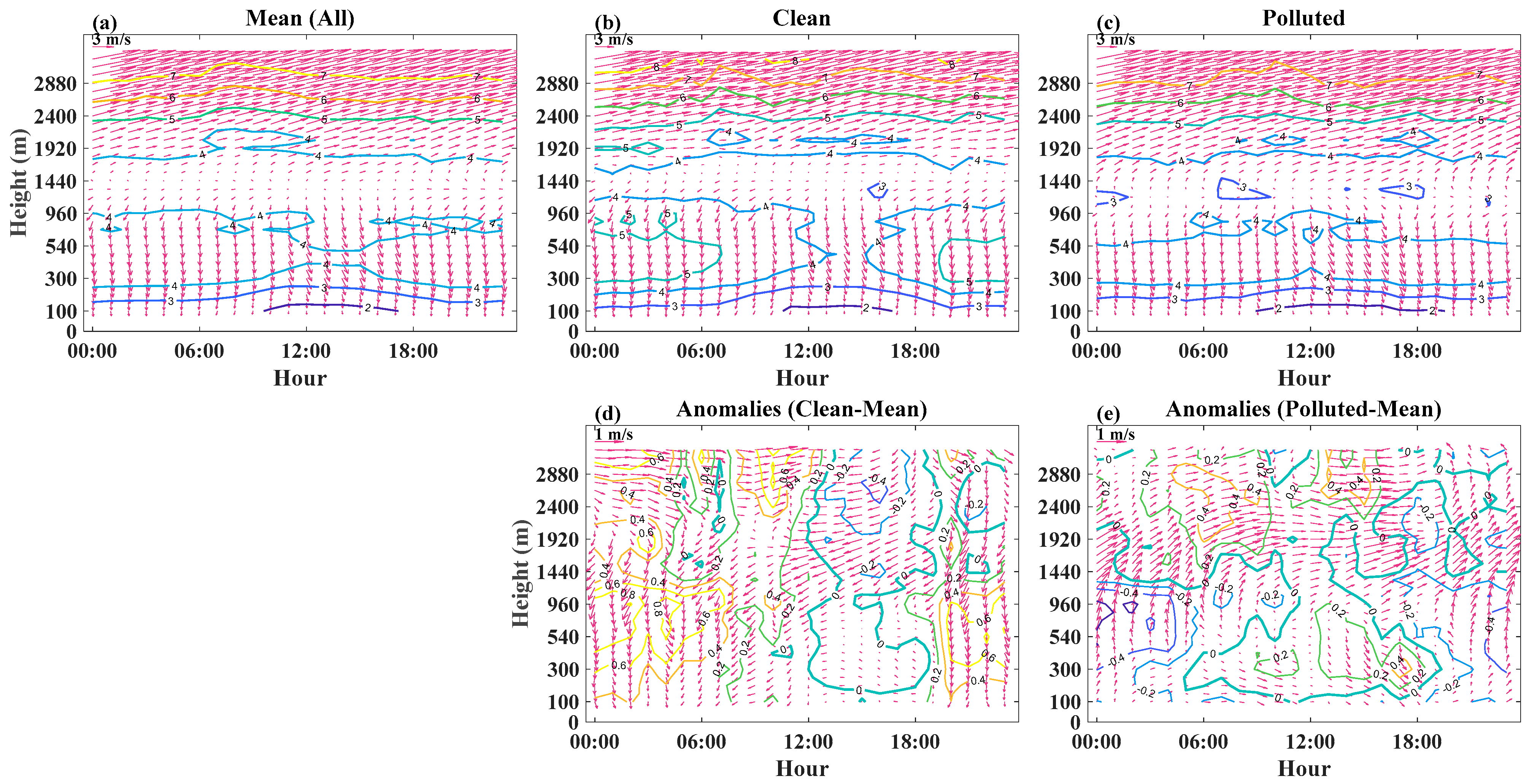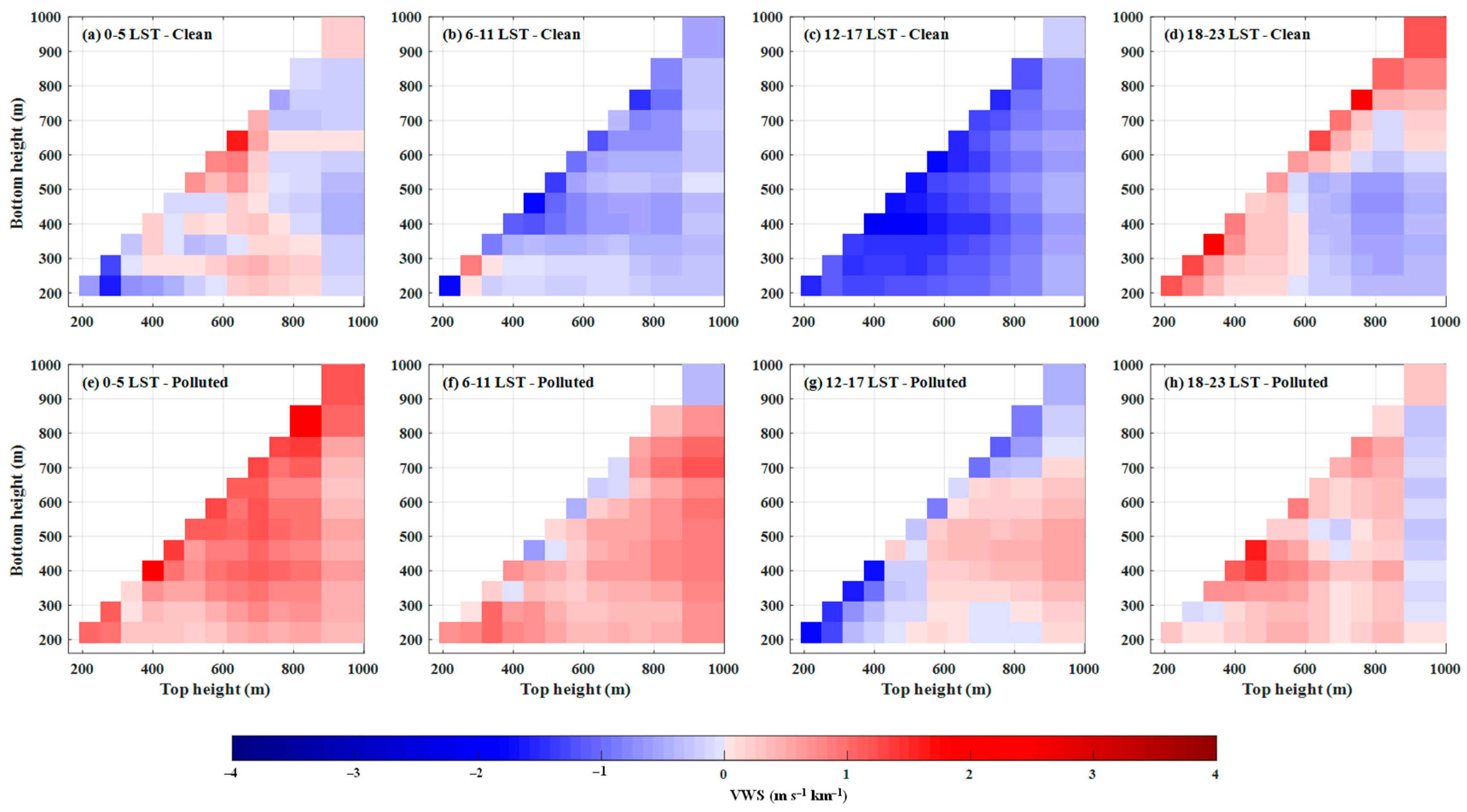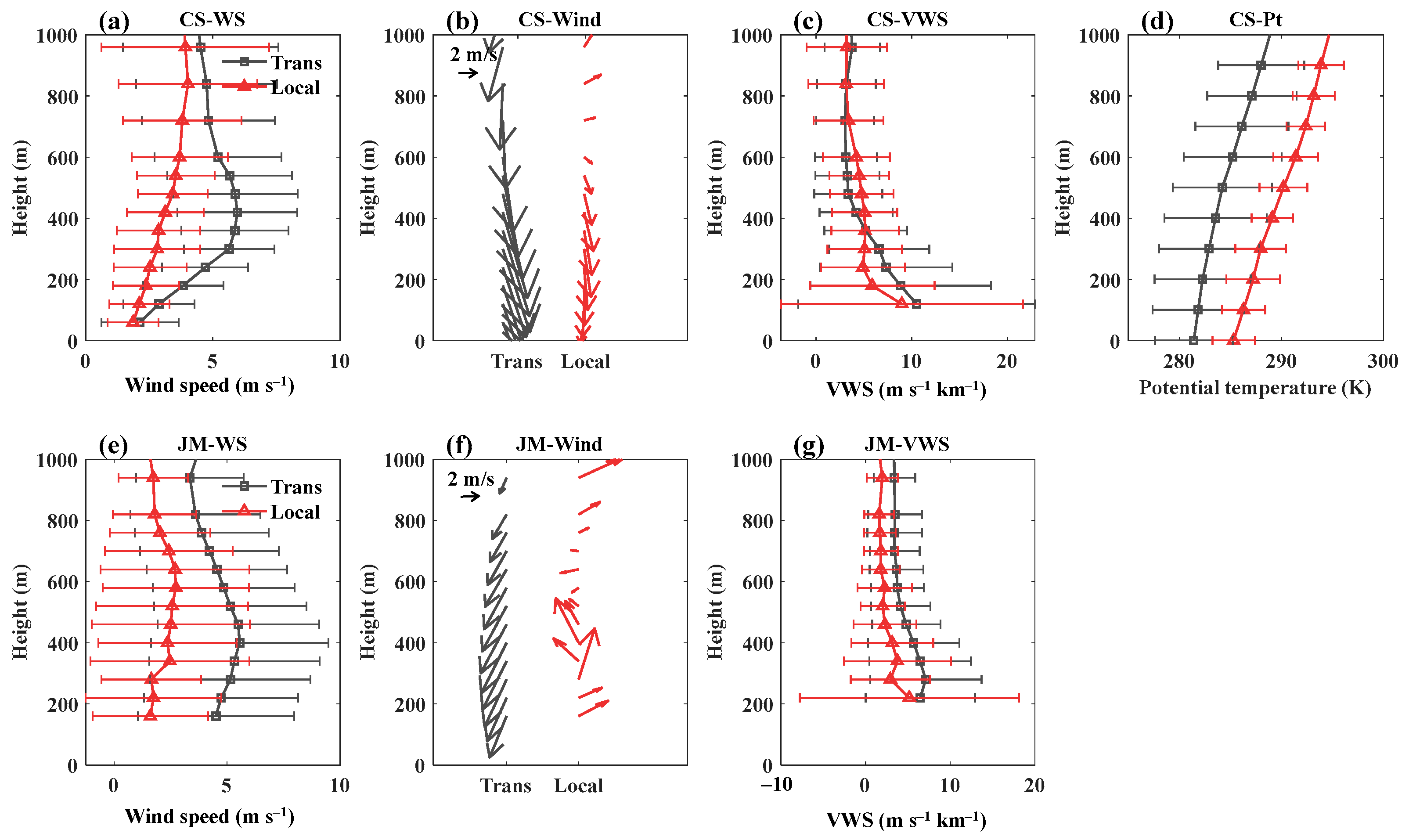Effect of Vertical Wind Shear on PM2.5 Changes over a Receptor Region in Central China
Abstract
:1. Introduction
2. Data and Methods
2.1. Data
2.1.1. Ground-Based Meteorological and Environmental Data
2.1.2. RWP and Radiosonde Measurements
2.2. Methods
2.3. WRF-FLEXPART Modeling
2.3.1. Model Description
2.3.2. WRF Modeling Configuration and Meteorological Validation
2.3.3. Estimation of the Contribution of Regional PM2.5 Transport
3. Results and Discussion
3.1. Wintertime Variations in Surface Conditions
3.2. Diurnal Variations of Vertical Winds
3.3. Effect of Vertical Wind Shear on PM2.5 Concentration
3.4. Backward Trajectory Modeling Analysis
3.5. Causes for Transport- and Local-Type PM2.5 Pollution
4. Conclusions
Supplementary Materials
Author Contributions
Funding
Data Availability Statement
Acknowledgments
Conflicts of Interest
References
- Peng, J.; Chen, S.; Lü, H.L.; Liu, Y.X.; Wu, J.S. Spatiotemporal patterns of remotely sensed PM 2.5 concentration in China from 1999 to 2011. Remote Sens. Environ. 2016, 174, 109–121. [Google Scholar] [CrossRef]
- Wang, X.Y.; Wang, K.C.; Su, L.Y. Contribution of atmospheric diffusion conditions to the recent improvement in air quality in China. Sci. Rep. 2016, 6, 36404. [Google Scholar] [CrossRef] [PubMed] [Green Version]
- Cao, J.J.; Wang, Q.Y.; Chow, J.C.; Watson, J.G.; Tie, X.X.; Shen, Z.X.; Wang, P.; An, Z.S. Impacts of aerosol compositions on visibility impairment in Xi’an, China. Atmos. Environ. 2012, 59, 559–566. [Google Scholar] [CrossRef]
- Crouse, D.L.; Peters, P.A.; van Donkelaar, A.; Goldberg, M.S.; Villeneuve, P.J.; Brion, O.; Khan, S.; Atari, D.O.; Jerrett, M.; Pope III, C.A. Risk of nonaccidental and cardiovascular mortality in relation to long-term exposure to low concentrations of fine particulate matter: A Canadian national-level cohort study. Environ. Health Perspect. 2012, 120, 708–714. [Google Scholar] [CrossRef]
- Zhang, X.Y.; Xu, X.D.; Ding, Y.H.; Liu, Y.J.; Zhang, H.D.; Wang, Y.Q.; Zhong, J.T. The impact of meteorological changes from 2013 to 2017 on PM 2.5 mass reduction in key regions in China. Sci. China Earth Sci. 2019, 62, 1885–1902. [Google Scholar] [CrossRef]
- Xiao, Q.; Zheng, Y.; Geng, G.; Chen, C.; Huang, X.; Che, H.; Zhang, X.; He, K.; Zhang, Q. Separating emission and meteorological contributions to long-term PM2.5 trends over eastern China during 2000–2018. Atmos. Chem. Phys. 2021, 21, 9475–9496. [Google Scholar] [CrossRef]
- Gong, S.L.; Liu, H.L.; Zhang, B.H.; He, J.J.; Zhang, H.D.; Wang, Y.Q.; Wang, S.X.; Zhang, L.; Wang, J. Assessment of meteorology vs. control measures in the China fine particular matter trend from 2013 to 2019 by an environmental meteorology index. Atmos. Chem. Phys. 2021, 21, 2999–3013. [Google Scholar] [CrossRef]
- Zheng, B.; Tong, D.; Li, M.; Liu, F.; Hong, C.P.; Geng, G.N.; Li, H.Y.; Li, X.; Peng, L.Q.; Qi, J. Trends in China’s anthropogenic emissions since 2010 as the consequence of clean air actions. Atmos. Chem. Phys. 2018, 18, 14095–14111. [Google Scholar] [CrossRef] [Green Version]
- Zhang, Q.; Ma, Q.; Zhao, B.; Liu, X.; Wang, Y.; Jia, B.; Zhang, X. Winter haze over North China Plain from 2009 to 2016: Influence of emission and meteorology. Environ. Pollut. 2018, 242, 1308–1318. [Google Scholar] [CrossRef]
- Huang, X.; Ding, A.; Wang, Z.; Ding, K.; Gao, J.; Chai, F.; Fu, C. Amplified transboundary transport of haze by aerosol–boundary layer interaction in China. Nat. Geosci. 2020, 13, 428–434. [Google Scholar] [CrossRef]
- Cai, W.; Li, K.; Liao, H.; Wang, H.; Wu, L. Weather conditions conducive to Beijing severe haze more frequent under climate change. Nat. Clim. Chang. 2017, 7, 257–262. [Google Scholar] [CrossRef]
- Zou, Y.; Wang, Y.; Zhang, Y.; Koo, J.-H. Arctic sea ice, Eurasia snow, and extreme winter haze in China. Sci. Adv. 2017, 3, e1602751. [Google Scholar] [CrossRef] [PubMed] [Green Version]
- Lu, M.M.; Tang, X.; Wang, Z.F.; Gbaguidi, A.; Liang, S.W.; Hu, K.; Wu, L.; Wu, H.J.; Huang, Z.; Shen, L.J. Source tagging modeling study of heavy haze episodes under complex regional transport processes over Wuhan megacity, Central China. Environ. Pollut. 2017, 231, 612–621. [Google Scholar] [CrossRef] [PubMed]
- Li, K.; Liao, H.; Cai, W.J.; Yang, Y. Attribution of anthropogenic influence on atmospheric patterns conducive to recent most severe haze over eastern China. Geophys. Res. Lett. 2018, 45, 2072–2081. [Google Scholar] [CrossRef]
- Bai, K.; Li, K.; Guo, J.; Cheng, W.; Xu, X. Do More Frequent Temperature Inversions Aggravate Haze Pollution in China? Geophys. Res. Lett. 2022, 49, e2021GL096458. [Google Scholar] [CrossRef]
- Ding, A.; Huang, X.; Nie, W.; Sun, J.; Kerminen, V.M.; Petäjä, T.; Su, H.; Cheng, Y.; Yang, X.Q.; Wang, M. Enhanced haze pollution by black carbon in megacities in China. Geophys. Res. Lett. 2016, 43, 2873–2879. [Google Scholar] [CrossRef]
- Huang, X.; Wang, Z.; Ding, A. Impact of aerosol-PBL interaction on haze pollution: Multiyear observational evidences in North China. Geophys. Res. Lett. 2018, 45, 8596–8603. [Google Scholar] [CrossRef] [Green Version]
- Dong, Z.; Li, Z.; Yu, X.; Cribb, M.; Li, X.; Dai, J. Opposite long-term trends in aerosols between low and high altitudes: A testimony to the aerosol–PBL feedback. Atmos. Chem. Phys. 2017, 17, 7997–8009. [Google Scholar] [CrossRef] [Green Version]
- Li, Z.; Guo, J.; Ding, A.; Liao, H.; Liu, J.; Sun, Y.; Wang, T.; Xue, H.; Zhang, H.; Zhu, B. Aerosol and boundary-layer interactions and impact on air quality. Natl. Sci. Rev. 2017, 4, 810–833. [Google Scholar] [CrossRef]
- Zheng, G.; Duan, F.; Su, H.; Ma, Y.; Cheng, Y.; Zheng, B.; Zhang, Q.; Huang, T.; Kimoto, T.; Chang, D. Exploring the severe winter haze in Beijing: The impact of synoptic weather, regional transport and heterogeneous reactions. Atmos. Chem. Phys. 2015, 15, 2969–2983. [Google Scholar] [CrossRef] [Green Version]
- Li, X.; Hu, X.-M.; Ma, Y.; Wang, Y.; Li, L.; Zhao, Z. Impact of planetary boundary layer structure on the formation and evolution of air-pollution episodes in Shenyang, Northeast China. Atmos. Environ. 2019, 214, 116850. [Google Scholar] [CrossRef]
- Zhang, K.; Wang, D.; Bian, Q.; Duan, Y.; Zhao, M.; Fei, D.; Xiu, G.; Fu, Q. Tethered balloon-based particle number concentration, and size distribution vertical profiles within the lower troposphere of Shanghai. Atmos. Environ. 2017, 154, 141–150. [Google Scholar] [CrossRef]
- Dolman, B.K.; Reid, I.M.; Tingwell, C. Stratospheric tropospheric wind profiling radars in the Australian network. Earth Planets Space 2018, 70, 170. [Google Scholar] [CrossRef] [Green Version]
- Molod, A.; Salmun, H.; Dempsey, M. Estimating planetary boundary layer heights from NOAA profiler network wind profiler data. J. Atmos. Ocean. Technol. 2015, 32, 1545–1561. [Google Scholar] [CrossRef]
- Ishihara, M.; Kato, Y.; Abo, T.; Kobayashi, K.; Izumikawa, Y. Characteristics and performance of the operational wind profiler network of the Japan Meteorological Agency. J. Meteorol. Soc. Jpn. Ser. II 2006, 84, 1085–1096. [Google Scholar] [CrossRef] [Green Version]
- Harvey, N.J.; Hogan, R.J.; Dacre, H.F. A method to diagnose boundary-layer type using Doppler lidar. Q. J. R. Meteorol. Soc. 2013, 139, 1681–1693. [Google Scholar] [CrossRef]
- Manninen, A.; Marke, T.; Tuononen, M.; O’Connor, E. Atmospheric boundary layer classification with Doppler lidar. J. Geophys. Res. Atmos. 2018, 123, 8172–8189. [Google Scholar] [CrossRef]
- Yang, Y.; Yim, S.H.; Haywood, J.; Osborne, M.; Chan, J.C.; Zeng, Z.; Cheng, J.C. Characteristics of heavy particulate matter pollution events over Hong Kong and their relationships with vertical wind profiles using high-time-resolution Doppler lidar measurements. J. Geophys. Res. Atmos. 2019, 124, 9609–9623. [Google Scholar] [CrossRef] [Green Version]
- Sekuła, P.; Bokwa, A.; Bartyzel, J.; Bochenek, B.; Chmura, Ł.; Gałkowski, M.; Zimnoch, M. Measurement report: Effect of wind shear on PM10 concentration vertical structure in the urban boundary layer in a complex terrain. Atmos. Chem. Phys. 2021, 21, 12113–12139. [Google Scholar] [CrossRef]
- Tie, X.; Zhang, Q.; He, H.; Cao, J.; Han, S.; Gao, Y.; Li, X.; Jia, X.C. A budget analysis of the formation of haze in Beijing. Atmos. Environ. 2015, 100, 25–36. [Google Scholar] [CrossRef]
- Liu, B.; Guo, J.; Gong, W.; Shi, L.; Zhang, Y.; Ma, Y. Characteristics and performance of wind profiles as observed by the radar wind profiler network of China. Atmos. Meas. Tech. 2020, 13, 4589–4600. [Google Scholar] [CrossRef]
- Zhang, Y.; Guo, J.; Yang, Y.; Wang, Y.; Yim, S.H. Vertical wind shear modulates particulate matter pollutions: A perspective from Radar wind profiler observations in Beijing, China. Remote Sens. 2020, 12, 546. [Google Scholar] [CrossRef] [Green Version]
- Huang, T.; Yim, S.H.-l.; Yang, Y.; Lee, O.S.-m.; Lam, D.H.-y.; Cheng, J.C.-h.; Guo, J. Observation of turbulent mixing characteristics in the typical daytime cloud-topped boundary layer over Hong Kong in 2019. Remote Sens. 2020, 12, 1533. [Google Scholar] [CrossRef]
- Shen, L.J.; Wang, H.L.; Zhao, T.L.; Liu, J.; Bai, Y.Q.; Kong, S.F.; Shu, Z.Z. Characterizing regional aerosol pollution in central China based on 19 years of MODIS data: Spatiotemporal variation and aerosol type discrimination. Environ. Pollut. 2020, 263, 114556. [Google Scholar] [CrossRef]
- Tan, C.; Zhao, T.; Xu, X.; Liu, J.; Zhang, L.; Tang, L. Climatic analysis of satellite aerosol data on variations of submicron aerosols over East China. Atmos. Environ. 2015, 123, 392–398. [Google Scholar] [CrossRef]
- Lin, C.Q.; Liu, G.H.; Lau, A.K.H.; Li, Y.; Li, C.C.; Fung, J.C.H.; Lao, X.Q. High-resolution satellite remote sensing of provincial PM2. 5 trends in China from 2001 to 2015. Atmos. Environ. 2018, 180, 110–116. [Google Scholar] [CrossRef]
- Bai, Y.; Zhao, T.; Hu, W.; Zhou, Y.; Xiong, J.; Wang, Y.; Liu, L.; Shen, L.; Kong, S.; Meng, K.; et al. Meteorological mechanism of regional PM2.5 transport building a receptor region for heavy air pollution over Central China. Sci. Total Environ. 2022, 808, 151951. [Google Scholar] [CrossRef]
- Zhong, J.T.; Zhang, X.Y.; Wang, Y.Q.; Wang, J.Z.; Shen, X.J.; Zhang, H.S.; Wang, T.J.; Xie, Z.Q.; Liu, C.; Zhang, H.D. The two-way feedback mechanism between unfavorable meteorological conditions and cumulative aerosol pollution in various haze regions of China. Atmos. Chem. Phys. 2019, 19, 3287–3306. [Google Scholar] [CrossRef] [Green Version]
- Yu, C.; Zhao, T.L.; Bai, Y.Q.; Zhang, L.; Kong, S.F.; Yu, X.N.; He, J.H.; Cui, C.G.; Yang, J.; You, Y.C. Heavy air pollution with a unique “non-stagnant” atmospheric boundary layer in the Yangtze River middle basin aggravated by regional transport of PM 2.5 over China. Atmos. Chem. Phys. 2020, 20, 7217–7230. [Google Scholar] [CrossRef]
- Sun, X.; Zhao, T.; Bai, Y.; Kong, S.; Zheng, H.; Hu, W.; Ma, X.; Xiong, J. Meteorology impact on PM 2.5 change over a receptor region in the regional transport of air pollutants: Observational study of recent emission reductions in central China. Atmos. Chem. Phys. 2022, 22, 3579–3593. [Google Scholar] [CrossRef]
- Ministry of Ecology and Environment of the People’s Republic of China. Available online: http://www.mee.gov.cn/ (accessed on 24 June 2022).
- China Meteorological Data Service Center. Available online: http://data.cma.cn/ (accessed on 24 June 2022).
- Miao, Y.; Guo, J.; Liu, S.; Wei, W.; Zhang, G.; Lin, Y.; Zhai, P. The climatology of low-level jet in Beijing and Guangzhou, China. J. Geophys. Res. Atmos. 2018, 123, 2816–2830. [Google Scholar] [CrossRef]
- Guo, J.; Deng, M.; Fan, J.; Li, Z.; Chen, Q.; Zhai, P.; Dai, Z.; Li, X. Precipitation and air pollution at mountain and plain stations in northern China: Insights gained from observations and modeling. J. Geophys. Res. Atmos. 2014, 119, 4793–4807. [Google Scholar] [CrossRef]
- Wang, X.; Dickinson, R.E.; Su, L.; Zhou, C.; Wang, K. PM2. 5 pollution in China and how it has been exacerbated by terrain and meteorological conditions. Bull. Am. Meteorol. Soc. 2018, 99, 105–119. [Google Scholar] [CrossRef]
- Markowski, P.; Richardson, Y. On the classification of vertical wind shear as directional shear versus speed shear. Weather Forecast. 2006, 21, 242–247. [Google Scholar] [CrossRef] [Green Version]
- Brioude, J.; Arnold, D.; Stohl, A.; Cassiani, M.; Morton, D.; Seibert, P.; Angevine, W.; Evan, S.; Dingwell, A.; Fast, J.D. The Lagrangian particle dispersion model FLEXPART-WRF version 3.1. Geosci. Model. Dev. 2013, 6, 1889–1904. [Google Scholar] [CrossRef] [Green Version]
- Karmakar, S.; Srinivas, C.; Rakesh, P.; Venkatesan, R.; Venkatraman, B. A WRF-FLEXPART simulation study of oil-fire plume dispersion-sensitivity to turbulent diffusion schemes. Meteorol. Atmos. Phys. 2022, 134, 32. [Google Scholar] [CrossRef]
- Grell, G.A.; Peckham, S.E.; Schmitz, R.; McKeen, S.A.; Frost, G.; Skamarock, W.C.; Eder, B. Fully coupled “online” chemistry within the WRF model. Atmos. Environ. 2005, 39, 6957–6975. [Google Scholar] [CrossRef]
- Hong, S.Y.; Noh, Y. A New Vertical Diffusion Package with an Explicit Treatment of Entrainment Processes. Mon. Weather Rev. 2006, 134, 2318–2341. [Google Scholar] [CrossRef] [Green Version]
- Mlawer, E.J.; Taubman, S.J.; Brown, P.D.; Iacono, M.J.; Clough, S.A. Radiative transfer for inhomogeneous atmospheres: RRTM, a validated correlated-k model for the longwave. J. Geophys. Res. Atmos. 1997, 102, 16663–16682. [Google Scholar] [CrossRef] [Green Version]
- Chou, M.D.; Suarez, M.J. Parameterizations for Cloud Overlapping and Shortwave Single-Scattering. J. Clim. 1998, 11, 202–214. [Google Scholar] [CrossRef]
- Lin, Y.L.; Farley, R.D.; Orville, H.D. Bulk Parameterization of the Snow Field in a Cloud Model. J. Clim. Appl. Meteorol. 1983, 22, 1065–1092. [Google Scholar] [CrossRef] [Green Version]
- National Centers for Environmental Prediction; NWS; NOAA; U.S. Department of Commerce. NCEP FNL Operational Model Global Tropospheric Analyses, Continuing from July 1999. Available online: https://doi.org/10.5065/D6M043C6 (accessed on 24 June 2022).
- Boylan, J.W.; Russell, A.G. PM and light extinction model performance metrics, goals, and criteria for three-dimensional air quality models. Atmos. Environ. 2006, 40, 4946–4959. [Google Scholar] [CrossRef]
- Morris, R.E.; McNally, D.E.; Tesche, T.W.; Tonnesen, G.; Boylan, J.W.; Brewer, P. Preliminary evaluation of the Community Multiscale Air Quality model for 2002 over the southeastern United States. J. Air Waste Manag. Assoc. 2005, 55, 1694–1708. [Google Scholar] [CrossRef] [PubMed]
- Stohl, A.; Forster, C.; Eckhardt, S.; Spichtinger, N.; Huntrieser, H.; Heland, J.; Schlager, H.; Wilhelm, S.; Arnold, F.; Cooper, O. A backward modeling study of intercontinental pollution transport using aircraft measurements. J. Geophys. Res. Atmos. 2003, 108, 4370. [Google Scholar] [CrossRef]
- Stohl, A.; Forster, C.; Frank, A.; Seibert, P.; Wotawa, G. The Lagrangian particle dispersion model FLEXPART version 6.2. Atmos. Chem. Phys. 2005, 5, 2461–2474. [Google Scholar] [CrossRef] [Green Version]
- Ding, A.; Wang, T.; Xue, L.; Gao, J.; Stohl, A.; Lei, H.; Jin, D.; Ren, Y.; Wang, X.; Wei, X. Transport of north China air pollution by midlatitude cyclones: Case study of aircraft measurements in summer 2007. J. Geophys. Res. Atmos. 2009, 114, D08304. [Google Scholar] [CrossRef] [Green Version]
- Multi-Resolution Emission Inventory for China. Available online: http://meicmodel.org (accessed on 24 June 2022).
- Yu, R.; Li, J.; Chen, H. Diurnal variation of surface wind over central eastern China. Clim. Dyn. 2009, 33, 1089–1097. [Google Scholar] [CrossRef]
- Wang, H.; Li, Z.; Lv, Y.; Zhang, Y.; Xu, H.; Guo, J.; Goloub, P. Determination and climatology of the diurnal cycle of the atmospheric mixing layer height over Beijing 2013–2018: Lidar measurements and implications for air pollution. Atmos. Chem. Phys. 2020, 20, 8839–8854. [Google Scholar] [CrossRef]
- He, J.; Gong, S.; Yu, Y.; Yu, L.; Wu, L.; Mao, H.; Song, C.; Zhao, S.; Liu, H.; Li, X. Air pollution characteristics and their relation to meteorological conditions during 2014–2015 in major Chinese cities. Environ. Pollut. 2017, 223, 484–496. [Google Scholar] [CrossRef]
- Chen, Z.Y.; Chen, D.L.; Zhao, C.F.; Kwan, M.-P.; Cai, J.; Zhuang, Y.; Zhao, B.; Wang, X.Y.; Chen, B.; Yang, J. Influence of meteorological conditions on PM2. 5 concentrations across China: A review of methodology and mechanism. Environ. Int. 2020, 139, 105558. [Google Scholar] [CrossRef]
- Ren, J.; Liu, J.; Li, F.; Cao, X.; Ren, S.; Xu, B.; Zhu, Y. A study of ambient fine particles at Tianjin International Airport, China. Sci. Total Environ. 2016, 556, 126–135. [Google Scholar] [CrossRef] [PubMed]
- Yang, Q.; Yuan, Q.; Li, T.; Shen, H.; Zhang, L. The relationships between PM2. 5 and meteorological factors in China: Seasonal and regional variations. Int. J. Environ. Res. Public Health 2017, 14, 1510. [Google Scholar] [CrossRef] [PubMed] [Green Version]
- Yuan, S.; Xu, W.; Liu, Z. A study on the model for heating influence on PM2. 5 emission in Beijing China. Procedia Eng. 2015, 121, 612–620. [Google Scholar] [CrossRef] [Green Version]
- Zhao, D.; Xin, J.; Gong, C.; Quan, J.; Liu, G.; Zhao, W.; Wang, Y.; Liu, Z.; Song, T. The formation mechanism of air pollution episodes in Beijing city: Insights into the measured feedback between aerosol radiative forcing and the atmospheric boundary layer stability. Sci. Total Environ. 2019, 692, 371–381. [Google Scholar] [CrossRef]
- Han, S.-q.; Hao, T.-y.; Zhang, Y.-f.; Li, P.-y.; Cai, Z.-y.; Zhang, M.; Wang, Q.-l.; Zhang, H. Vertical observation and analysis on rapid formation and evolutionary mechanisms of a prolonged haze episode over central-eastern China. Sci. Total Environ. 2018, 616, 135–146. [Google Scholar] [CrossRef] [PubMed]
- Doswell III, C.A. A review for forecasters on the application of hodographs to forecasting severe thunderstorms. Natl. Weather Dig. 1991, 16, 2–16. [Google Scholar]
- Gu, Y.; Yim, S.H.L. The air quality and health impacts of domestic trans-boundary pollution in various regions of China. Environ. Int. 2016, 97, 117–124. [Google Scholar] [CrossRef]
- Shen, L.; Hu, W.; Zhao, T.; Bai, Y.; Wang, H.; Kong, S.; Zhu, Y. Changes in the Distribution Pattern of PM 2.5 Pollution over Central China. Remote Sens. 2021, 13, 4855. [Google Scholar] [CrossRef]











| CS | JM | ||
|---|---|---|---|
| RWP | Coordinates | 112.79°E, 28.11°N | 112.21°E, 30.99°N |
| Versions | CFL-03 | CLC-11-D | |
| Vertical levels below 3 km | 32 | 27 | |
| Time resolution | 6 min | 6 min | |
| Initial altitude | 100 m | 100 m | |
| Vertical resolution | <1 km: 60 m >1 km: 120 m | <800 m: 60 m 800–1900 m: 120 m >1900 m: 240 m | |
| Parameters | Wind speed, wind direction | Wind speed, wind direction | |
| Radiosonde | Coordinate | 113.08°E, 28.20°N | / |
| Time resolution | launched twice per day at 08:00 and 20:00 LST | / | |
| Parameters | Temperature, pressure, relative humidity | / |
| Averaged PM2.5 Concentrations (μg m–3) | Averaged Wind Speed (m s–3) | Correlation Coefficients | ||
|---|---|---|---|---|
| Mean | 79.82 ± 46.67 | 2.84 ± 1.60 | ||
| CS | Clean | 41.77 ± 1.02 | 2.96 ± 0.14 | −0.24 * |
| Polluted | 124.89 ± 2.81 | 2.90 ± 0.18 | 0.16 * | |
| Mean | 91.28 ± 47.05 | 3.63 ± 2.01 | ||
| JM | Clean | 48.24 ± 2.66 | 3.86 ± 0.18 | −0.12 * |
| Polluted | 140.11 ± 3.06 | 3.58 ± 0.17 | 0.11 * |
| Hubei | Hunan | Henan | Anhui | Jiangxi | Others | |
|---|---|---|---|---|---|---|
| CS | 13.4 | 68.5 | 0.7 | 1.3 | 6.5 | 9.6 |
| JM | 50.7 | 7.0 | 20.8 | 5.5 | 0.1 | 15.9 |
| Transport-Type | Local-Type | ||||
|---|---|---|---|---|---|
| Date | Daily PM2.5 Concentrations (μg m–3) | Date | Daily PM2.5 Concentrations (μg m–3) | ||
| CS | JM | CS | JM | ||
| 30 January 2017 | 126.67 ± 17.48 | 92.74 ± 68.10 | 4 January 2017 | 215.87 ± 13.18 | 165.17 ± 18.89 |
| 17 February 2017 | 116.61 ± 89.55 | 92.25 ± 64.51 | 5 February 2018 | 121.84 ± 21.54 | 188.76 ± 72.97 |
| 4 December 2017 | 118.34 ± 54.10 | 209.72 ± 92.38 | 16 February 2018 | 167.29 ± 33.29 | 149.85 ± 27.76 |
| 5 December 2017 | 168.18 ± 56.61 | 175.07 ± 36.67 | 1 December 2018 | 263.44 ± 6.05 | 221.30 ± 15.25 |
| 29 January 2019 | 147.12 ± 15.21 | 174.20 ± 12.87 | 14 December 2019 | 164.07 ± 22.44 | 153.38 ± 17.95 |
| Average | 135.38 ± 53.91 | 148.80 ± 91.31 | 186.50 ± 57.53 | 175.69 ± 67.73 | |
Publisher’s Note: MDPI stays neutral with regard to jurisdictional claims in published maps and institutional affiliations. |
© 2022 by the authors. Licensee MDPI, Basel, Switzerland. This article is an open access article distributed under the terms and conditions of the Creative Commons Attribution (CC BY) license (https://creativecommons.org/licenses/by/4.0/).
Share and Cite
Sun, X.; Zhou, Y.; Zhao, T.; Bai, Y.; Huo, T.; Leng, L.; He, H.; Sun, J. Effect of Vertical Wind Shear on PM2.5 Changes over a Receptor Region in Central China. Remote Sens. 2022, 14, 3333. https://doi.org/10.3390/rs14143333
Sun X, Zhou Y, Zhao T, Bai Y, Huo T, Leng L, He H, Sun J. Effect of Vertical Wind Shear on PM2.5 Changes over a Receptor Region in Central China. Remote Sensing. 2022; 14(14):3333. https://doi.org/10.3390/rs14143333
Chicago/Turabian StyleSun, Xiaoyun, Yue Zhou, Tianliang Zhao, Yongqing Bai, Tao Huo, Liang Leng, Huan He, and Jing Sun. 2022. "Effect of Vertical Wind Shear on PM2.5 Changes over a Receptor Region in Central China" Remote Sensing 14, no. 14: 3333. https://doi.org/10.3390/rs14143333
APA StyleSun, X., Zhou, Y., Zhao, T., Bai, Y., Huo, T., Leng, L., He, H., & Sun, J. (2022). Effect of Vertical Wind Shear on PM2.5 Changes over a Receptor Region in Central China. Remote Sensing, 14(14), 3333. https://doi.org/10.3390/rs14143333







